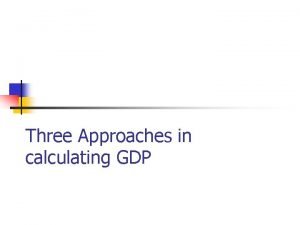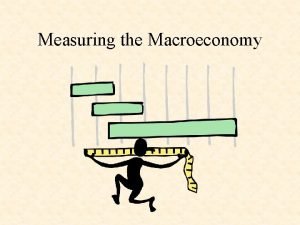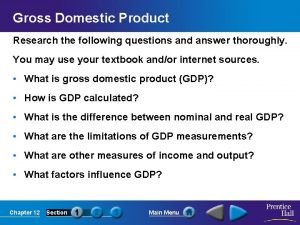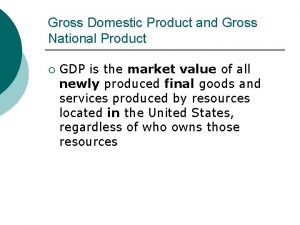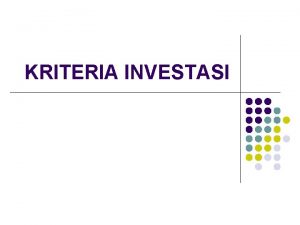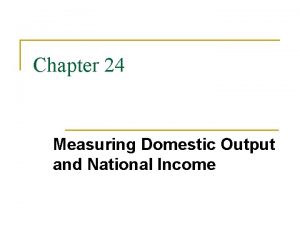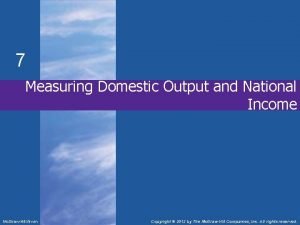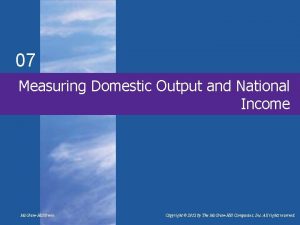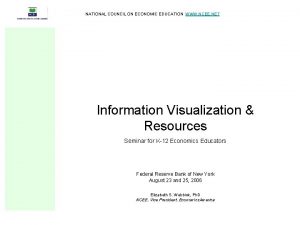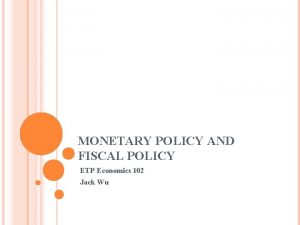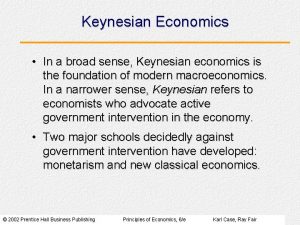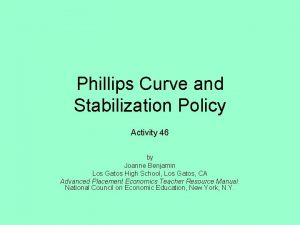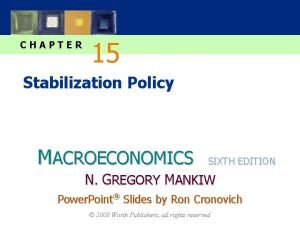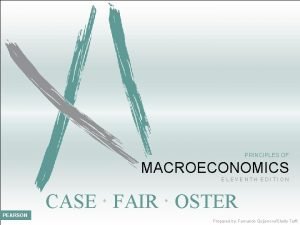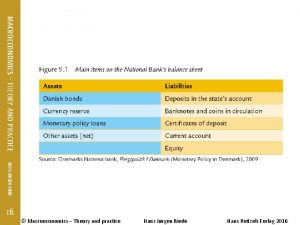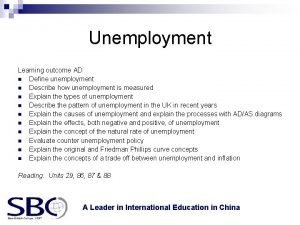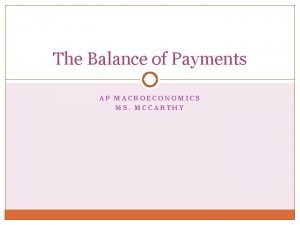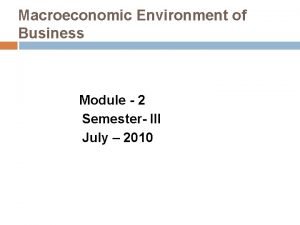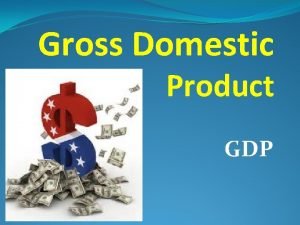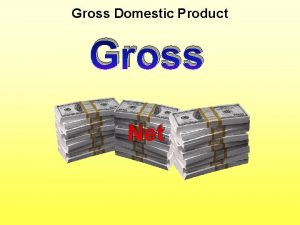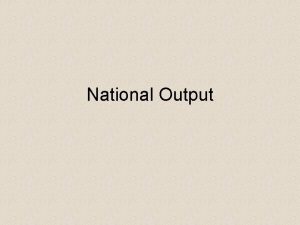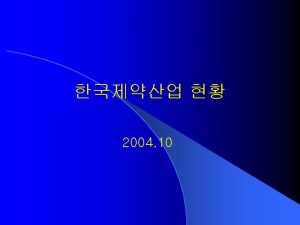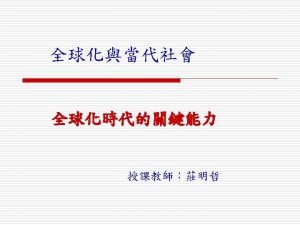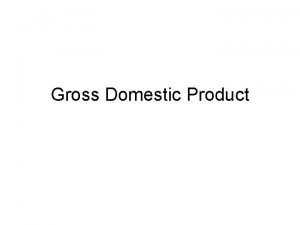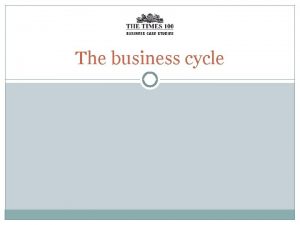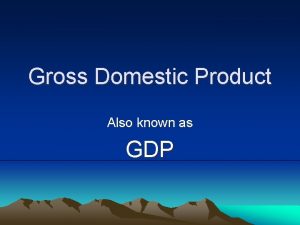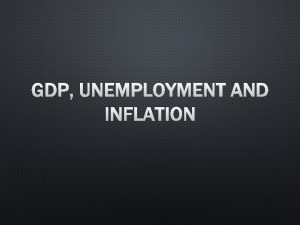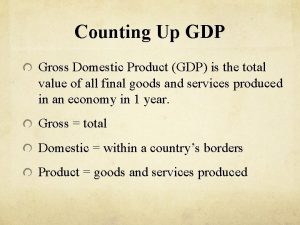Macroeconomics The GDP National Economic Measurement Gross Domestic


















































































- Slides: 82

Macroeconomics The GDP: National Economic Measurement

Gross Domestic Product

Gross Domestic Product • Gross Domestic Product (or GDP): the total dollar value of all final goods and services produced within a country during one calendar year • Economists use it to compare our economic system with other countries’ systems, and to compare the strength of our own economy from year to year

How economists calculate the GDP: • They use final output: total production within the nation’s borders in one year without counting products more than once. • Which of these would be counted in the GDP? • A. A tree cut by a woodcutter who sells it to a lumber yard. • B. The lumber bought by the lumber yard who then sells it to a furniture manufacturer. • C. A table made by the manufacturer now sold to a couple in Detroit, Michigan.

Calculating the GDP • They use only products produced in the current year. This would exclude things bought at yard sales, used cars, sale of most homes, etc. • Which of the following was used in the calculation of the GDP in 2016? • A car manufactured in 2015 but sold in 2016. • A used 2013 Toyota that was sold to Ms. Simpson in Memphis in 2016. • A Ford F 150 produced in 2016 but sold in 2017.

Calculating the GDP • They use only items produced within national borders. • Would this include or exclude Coca-Cola (a U. S. company) produced at a plant in Russia? • Exclude • GDP: A measure of the strength of our economy

Famous Economic Formula: Calculating GDP = C+I +G+(X-M)

C = Personal consumption expenditures (consumer spending). • Includes: • durable goods: a lifetime of more than one year, and • non-durable goods: a lifetime of less than one year, and services.

I = Gross Investment • Total value of all capital goods produced in a given nation during one year. • Fixed investment: Buildings, machinery, equipment • Inventory investment: raw materials, intermediate goods, final goods

G = Government Purchases • the dollar amount that federal, state, and local governments spend on items • i. e. , highways, education, defense, etc.

X-M: Net Exports •

Using the figures for 2015, calculate the GDP for that year. • 1995: C=4. 9 I =1. 1 G=1. 4 X-M= -. 1 • 7. 3 billion **I MADE THESE NUMBERS UP…**

• If we begin comparing GDP for each year, will price increases (inflation) cause more recent years to appear “inflated? ” • YES

Real vs. Nominal GDP • To adjust GDP for price increases economists calculate both • NOMINAL GDP: the current GDP expressed in current prices • REAL GDP: which is adjusted for price increases-inflation

“Real” GDP • GDP for one year expressed in the dollar of another, base year • Ex: 2010 GDP in 2000 dollar value Also known as Constant GDP

“Nominal” GDP • GDP expressed in the dollar value of a given year. • Ex: 2010 GDP in 2010 dollar value Also known as Current GDP

GDP measures economic growth or decline • Changes in Real GDP helps to determine if the economy has increased or decreased its actual production of new products

Limitations of GDP • Non-market activities: GDP does not include goods and services that people make or do themselves • i. e. baby-sitting, mowing the lawn, cooking dinner, washing cars • Underground economies: production and income not reported to the government • i. e. black market products: illegal drugs, weapons, stolen goods, exotic pets

Limitations of GDP • Negative Externalities: unintended economic side effects, or externalities that have monetary value not reflected in the GDP • Quality of Life: Some things that improve well-being cannot be included in GDP • i. e. pleasant surroundings, ample leisure time, personal safety

GDP does NOT include: • • • value of used products value of volunteer work purely financial transactions value of intermediary goods Transfer of assets

Real GDP per Capita •

GNP • Gross National Product: annual income earned by U. S. owned firms and U. S. citizens • Market value of all goods produced by Americans all over the world in one year

Economic Challenges Unemployment and Inflation

Unemployment • To again monitor the health of our economy, economists measure the Unemployment Rate. • Each month, the Bureau of Labor and Statistics survey certain Americans to find out their employment status. • The U. S. Government defines “employed” as people 16 and older meeting one or more of the following criteria.

“The Employed” 1. Working for pay or profit for 1 or more hours this week. 2. Working without pay in a family business 15 or more hours. 3. Having a job, but being ABSENT due to illness, weather, vacation, etc.

The U. S. Government defines “unemployed” as: 1. NOT meeting any of the criteria on the previous slide AND 2. ACTIVELY looking for work during the past 4 weeks. • The most closely watched and highly publicized labor force statistic is the UNEMPLOYMENT RATE – the percentage of people in the civilian labor force who are UNEMPLOYED.

Measuring Unemployment 2015 Total Population 321, 418, 00 Under 16 and institutionalized Not in labor force 70, 617, 000 93, 671, 000 148, 834, 000 Employed Labor force 157, 130, 000 Unemployed 8, 296, 000

Measuring Unemployment rate = unemployed labor force x 100

4 Types of Unemployment • Structural • Cyclical • Frictional • Seasonal

STRUCTURAL • Unemployment that occurs as a result of changes in technology, consumer preferences, or in the way the economy is “STRUCTURED. ” • EX: Many TV repairmen had to find new work as televisions are now built with transistors instead of tubes.

CYCLICAL • This unemployment results from contractions in the economy. • This type of unemployment HARMS the economy more than any other types of unemployment. • During the Great Depression, the unemployment rate reached an all time high of about 25%. • As recently as 2009 and 2010, the unemployment rate reached 10. 2%.

FRICTIONAL • People who have decided to leave one job and LOOK for another typically better job. • Also, new entrants and re-entrants into the LABOR FORCE. • Economists consider frictional unemployment as a NORMAL part of a healthy and changing ECONOMY.

SEASONAL • This predictable unemployment fluctuates as a result of HOLIDAYS, school breaks, and industry PRODUCTION schedules.

Inflation An increase in the average price level of all products in an economy

INFLATION • As prices increase, the amount that a dollar buys decreases. • Inflation reduces the real purchasing power of the dollar. • Real GDP removes inflation.

Demand-Pull Inflation • Inflation that occurs when demand for goods and services exceeds existing supplies • Heavy demand make items more valuable, forcing prices up.

Effects of Demand-Pull Inflation • Decrease in purchasing power • Erodes fixed income • Interest Rates • Savings lose value • Loaners lose profit

Cost-Push Inflation • Occurs when producers raise prices in order to meet increased costs • Costs for factors of production increase (commonly labor) which forces prices to rise.

DEFLATION • A decrease in the average price level of all goods and services in an economy. • The most prolonged and most recent deflationary period in the U. S. occurred during the Great Depression, when the unemployment rate was high and wages were low

• How do they measure prices of all goods? • How do they know that prices are going up or down?

Price Indexes • A price index is a number that tells us how much prices have changed (%) since a base year

Price Index Example • If the 1998 price index is 128, and the base year is 1992, then prices have increased 28% between 1992 and 1998 Index = 128 1992 Index = 100 Price increase= 28 General price rises are called INFLATION

CPI • Economists use the Consumer Price Index or the CPI to measure the average change over time in the price of a fixed group of products. • To measure the CPI, the Bureau of Labor Statistics first chooses a base year against which to measure price changes.

• Second, they select a representative sample of commonly purchased consumer items, called the market basket. They then set that base year to 100, so that other years can be compared to it easily.

• To calculate the CPI, take the price of this year’s cost of the market basket. • • Divide it by the cost of the basket in the base year. Multiply the result by 100. This year’s cost / base year’s cost x 100 For ex. Use the formula to determine the CPI if the year’s cost is $7000 and the base year’s cost was $4000.

• This year’s cost= $7000 • Divided by base year’s cost($4000) = 1. 75 • 1. 75 x 100 = 175


POVERTY • The poverty rate: the percentage of individuals or families in the total population that are living below the poverty threshold • Poverty threshold: the lowest income a family or household of a certain size needs to maintain a basic standard of living.

2015/2016 Poverty Threshold • In 2015, the poverty threshold for a family of four (two adults, two kids) was $24, 036 2016 Poverty Guidelines for the 48 Contiguous States and the District of Columbia Persons in Household Poverty Guideline For households of >8 persons, add $4, 160/person 1 $11, 880 2 16, 020 3 20, 160 4 24, 300 5 28, 440 6 32, 580 7 36, 730

Business Cycles

Business Cycles • Fluctuations in Real GDP are referred to as Business Cycles. • The duration and intensity of each phase of the Business Cycle are not always clear. • Business Cycles are typical of market, capitalistic economies due to the free nature of those economic systems

Phases of the Business Cycle • Expansion • Peak • Contraction • Trough

Expansions • Expansions are periods of increasing Real GDP. • Unemployment decreases, businesses expand, and Personal Consumption increases. • As expansions continue, there tend to be upward pressures on prices (inflation) and interest rates.

A Word About Interest Rates • The amount of money charged as a fee for lending money. • The price of borrowing money. • As interest rates rise LESS consumers will borrow money IF they are WILLING and ABLE • As interest rates fall MORE consumers will borrow money IF they are WILLING and ABLE

Peak • A peak is a period when the economy starts to level off. • Businesses postpone new investments, and consumer saving tends to increase. • Rising prices and interest rates tend to restrict purchases and investments, often leading to a Contraction.

Contraction • A Contraction is a period of declining Real GDP. • Consumer spending decreases, and unemployment increases as businesses layoff workers and shorten work hours. • Interest rates and prices level off, and often decline during long contractions.

Long Term Contractions • Recession: Six months of declining Real GDP • Depression: Twelve months of declining Real GDP coupled with at least 15% unemployment.

Trough • A Trough is the bottom of a Contraction. Lower interest rates and prices bring customers back to markets.

% Change in Real GDP Peak Expansion 0% Contraction Trough

Factors That Affect the Business Cycle • Business Investment: High levels of business investment (capital good increases like machinery and equipment) promote expansion. Low levels of business investment contribute to contraction. • Money and credit: When interest rates go up, people borrow less, and this less money is circulating in the economy, thus contributing to a contraction. (and vise versa)

Factors That Affect the Business Cycle • Public Expectations: People will increase their spending if they believe the economy is strong. This helps promote expansion. • External Factors: Like energy crisis and war.

Economic Indicators • Economic indicators are specific economic activities that have been historically good indicators of the general cycle of the economy. • Three types: • Leading • Coincident • Lagging

Leading Economic Indicators • Economic activities that tend to change 3 to 6 months before the general economy changes. • Examples: • • Stock market Orders for durable goods Housing Starts Number of new businesses Money supply Average work week Number of building permits issued

Coincident Economic Indicators • Economic activities that change at about the same time the general economy (GDP) changes • Examples: • • Personal income Industrial production levels Retail sales Number of employed nonagricultural workers

Lagging Economic Indicators • Economic activities that tend to change 3 to 6 months after the general economy (GDP) changes • Examples: • • Interest rates Unemployment duration Consumer debt load Number of business loans to be repaid

CLASSWORK • Draw a business cycle (ON THE PAGE PROVIDED IN THE PACKET) that contains all four phases. Describe the general mood that would be present among people during each phase. Most important, include an illustration, for each phase, of a related event to that phase of the business cycle – Consider the factor that affect the business cycle.

Aggregate Demand Aggregate Supply

Aggregate Demand is: • A schedule, graphically represented as a curve, which shows the various amounts of goods and services – the amounts of real domestic output – which domestic consumers, businesses, governments, and foreign buyers collectively will desire to purchase at each possible price level **Assumes a constant Money Supply**

Price Level AD Real Domestic Output (Real GDP) Less Domestic output will be produced and purchased at higher price levels and vice-versa

Determinants of A. D. • Wealth Effect – different price levels either increase or decrease the purchasing power of accumulated assets • Interest Rate Effect – different interest rates (due to different price levels) will either increase or decrease consumption of domestic output • Foreign Purchases Effect – different price levels will either increase or decrease foreign purchases of domestic output (net exports)

Factors that Shift Aggregate Demand • AD = C+I+G+(X-M) • Changes in Consumer Spending • Consumer Wealth • Consumer Expectations • Consumer Indebtedness • Taxes (Changes in. . . )

Factors that Shift Aggregate Demand • Changes in Investment Spending (Business) • Interest Rates • Profit expectations on investment projects • Business Taxes • Technology • Degree of Excess Capacity

Factors that Shift Aggregate Demand • Change in Government Spending • New national spending priorities • Budgetary cutbacks • Change in Net Export Spending • National income abroad • Exchange Rates


Examples: • Higher consumer indebtedness from past spending will limit current spending. What happens to AD? • AD decreases, shifts left • Increases in business taxes will limit current investment spending. What happens to AD? • AD decreases, shifts left • Depreciation (decreasing value) of the dollar will cause foreign currencies to be more valuable, increasing exports, decreasing imports. What happens to AD? • AD increases, shifts right.

Examples (Cont’d): • Decreases in interest rates, caused by changes in the money supply, will increase consumer spending and investment. What happens to AD? • AD increases, shifts right • Government cutbacks in purchases (e. g. military budget) will result in lower government spending • AD decreases, shifts left • New technology stimulates investment spending • AD increases, shifts right

Aggregate Supply • A schedule, graphically represented by a curve, showing the level of real domestic output (GDP) available at each possible price level

Price Levels AS Real Domestic Output (GDP)

Factors that Shift Aggregate Supply • Change in Input Prices • Resource availability and prices • Market Power of resource providers • Labor Unions • Monopoly resource owners • Changes in Productivity • Changes in Government Policies • Business Taxes and Subsidies • Government regulation


The Effects of a Shifts in Aggregate Demand • Changes in AD affect real GDP • If AD increases, what happens to the price level and real GDP? • If AD decreases, hwt happens to the price level and real GDP

The Effects of a Change in Aggregate Supply • What effect does a decrease in AS have on the priec level and real GDP? • What effect does and increase in aggregate supply have on the price level and real GDP?
 What is included in gdp
What is included in gdp Real gdp formula macroeconomics
Real gdp formula macroeconomics Real gdp formula
Real gdp formula What is included in gdp
What is included in gdp How to calculate nominal gdp with base year
How to calculate nominal gdp with base year 3 approaches to calculate gdp
3 approaches to calculate gdp Formula of gdp
Formula of gdp Gross domestic product in a closed economy consists of
Gross domestic product in a closed economy consists of Net exports formula
Net exports formula Rumus gross benefit cost ratio (gross b/c)
Rumus gross benefit cost ratio (gross b/c) Measuring domestic output and national income
Measuring domestic output and national income Difference between gdp and gnp
Difference between gdp and gnp Measuring domestic output and national income
Measuring domestic output and national income Measuring domestic output and national income
Measuring domestic output and national income Measuring domestic output and national income
Measuring domestic output and national income Tatlong pamamaraan ng national income
Tatlong pamamaraan ng national income Gnp and gdp difference
Gnp and gdp difference Hdi pillars
Hdi pillars Four pillars of gross national happiness
Four pillars of gross national happiness Gross national product definition ap human geography
Gross national product definition ap human geography Economic growth vs economic development
Economic growth vs economic development Prof. meier and baldwin
Prof. meier and baldwin Lesson 2 our economic choices
Lesson 2 our economic choices National council for economic education
National council for economic education Economics subject
Economics subject Components of macroeconomics
Components of macroeconomics Crowding out effect macroeconomics
Crowding out effect macroeconomics Crowding out effect macroeconomics
Crowding out effect macroeconomics Unit 5 lesson 2 fiscal and monetary policy
Unit 5 lesson 2 fiscal and monetary policy Meaning of managerial economics in simple words
Meaning of managerial economics in simple words What is the theory of liquidity preference
What is the theory of liquidity preference Micro and macro economics venn diagram
Micro and macro economics venn diagram New classical macroeconomics
New classical macroeconomics New classical macroeconomics
New classical macroeconomics Crowding out effect of fiscal policy
Crowding out effect of fiscal policy 2012 macroeconomics frq
2012 macroeconomics frq Macroeconomics circular flow diagram
Macroeconomics circular flow diagram Ap macroeconomics-percentage for a 5
Ap macroeconomics-percentage for a 5 Chapter 31 open economy macroeconomics
Chapter 31 open economy macroeconomics Macroeconomics deals with?
Macroeconomics deals with? Monetarist vs classical economics
Monetarist vs classical economics New classical macroeconomics
New classical macroeconomics Ap macroeconomics unit 3
Ap macroeconomics unit 3 Macroeconomics cheat sheet
Macroeconomics cheat sheet Ap macro graphs
Ap macro graphs Macroeconomics
Macroeconomics Macroeconomics lesson 3 activity 46
Macroeconomics lesson 3 activity 46 The components of macroeconomics
The components of macroeconomics Economics michael parkin 13th edition
Economics michael parkin 13th edition Macroeconomics ninth edition
Macroeconomics ninth edition Ap macro units
Ap macro units Macroeconomics chapter 7
Macroeconomics chapter 7 Founder of macroeconomics
Founder of macroeconomics Macroeconomics chapter 8
Macroeconomics chapter 8 Macroeconomics
Macroeconomics Macroeconomics
Macroeconomics Micro macro economics
Micro macro economics Site:slidetodoc.com
Site:slidetodoc.com Macroeconomics
Macroeconomics Macroeconomics
Macroeconomics Ap macroeconomics supply and demand analysis
Ap macroeconomics supply and demand analysis Macroeconomics
Macroeconomics Macroeconomics
Macroeconomics Principles of macroeconomics case fair oster
Principles of macroeconomics case fair oster Macroeconomics theory and practice
Macroeconomics theory and practice Macroeconomics
Macroeconomics Macroeconomics definition economics
Macroeconomics definition economics Macroeconomics
Macroeconomics Intermediate macroeconomics mankiw
Intermediate macroeconomics mankiw Macroeconomics
Macroeconomics 2012 ap macroeconomics free response answers
2012 ap macroeconomics free response answers Macroeconomics
Macroeconomics Rules vs discretion macroeconomics
Rules vs discretion macroeconomics Unemployment diagram
Unemployment diagram About fiscal policy
About fiscal policy Ap macroeconomics balance of payments
Ap macroeconomics balance of payments Monetary transmission mechanism
Monetary transmission mechanism I-upf
I-upf What is liquidity ratio in banking
What is liquidity ratio in banking Macroeconomics
Macroeconomics Importance of microeconomics
Importance of microeconomics Money demand
Money demand Explain the quantity theory of money
Explain the quantity theory of money





